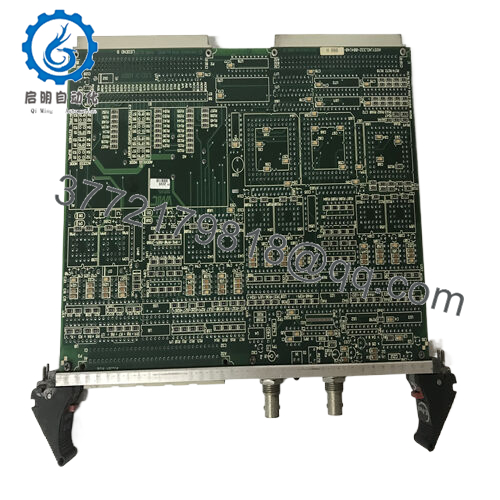Description
In the demanding realm of industrial automation, delivering precise analog commands to actuators—whether modulating valve positions in a chemical reactor or fine-tuning servo drives in a CNC mill—can falter when output signals succumb to noise, drift, or insufficient channel density, spawning inconsistencies that cascade into product defects, energy waste, or safety excursions. Picture a semiconductor fab where voltage offsets in DAC outputs skew etch depths, yielding scrap wafers by the thousands, or an oil rig’s hydraulic controls where ground loops amplify transients, delaying emergency shutdowns amid corrosive seas. These pitfalls are par for the course in process control environments like precision manufacturing or offshore platforms, where high reliability for I/O signals is the bedrock of throughput, yet legacy systems often force compromises: sparse channels mean added boards and wiring mazes, while unshielded outputs invite EMI sabotage in high-vibration zones, ballooning integration costs and debug drudgery.
The GE VMIVME-4140 counters this as a 32-channel, 12-bit analog output board for VMEbus systems, meticulously designed to instill command fidelity in embedded control architectures. It zeroes in on the pursuit of modular integration by packing double-buffered DACs into a single-slot footprint, enabling simultaneous updates across all channels without settling-time glitches—indispensable for retrofitting dense I/O in DCS expansions or layering into test simulators where scalability trumps sprawl. For engineers wrestling EMI-riddled cabinets or seismic-rated enclosures, the GE VMIVME-4140 stands out, its optically isolated outputs and offline test modes severing field ties for safe calibration, ensuring your automation stays locked on target amid the grind.
The hidden costs of erratic analog outputs extend deep: they erode loop accuracy in SCADA trends, complicate fault forensics in historians, and inflate OPEX through frequent recalibrations in distributed nodes. Armed with voltage/current sourcing and jumper-configurable ranges, the GE VMIVME-4140 enforces microsecond synchronization, letting you drive proportional valves or chart recorders with 0.01% linearity, transforming haphazard tweaks into orchestrated precision. It’s the quiet force multiplier for industrial automation, where output integrity doesn’t just serve; it sustains the pulse of mission-critical flows.
Weaving the GE VMIVME-4140 into your VME ecosystem is like arming your backplane with a precision orchestrator—it claims a single-height slot in standard VME64 crates, sourcing +5V from the P1/J1 pins while mapping A24/D32 space for block transfers up to 2 MB/s, funneling setpoint vectors from host SBCs like the VMIVME-7699 to its 32 independent DACs via dual-ported RAM. Perched in the I/O frontier of your stack, it conditions outputs for ±10V bipolar or 4-20 mA loops, with per-channel isolation up to 500V to quarantine field faults, then asserts interrupts for end-of-update flags that sync to real-time schedulers without bus contention.
In a live rig, you’d wire it to actuator terminals via discrete or ribbon cables, configuring ranges through onboard jumpers for current-loop compliance in hazardous areas, then leverage DMA bursts to preload buffers from your RTOS—say, VxWorks—for glitch-free ramps in motion profiling. This board doesn’t dictate; it adapts, supporting VSB extensions for multi-crate chaining or reflective memory for synchronized outputs across nodes, with built-in diagnostics that expose overrange via status registers, streamlining handshakes with upstream PLCs over Profibus gateways. In the Purdue model’s field tier, the GE VMIVME-4140 distills digital directives into analog grace, bridging control logic to physical realms with surge-protected terminals that weather 1kV transients, ensuring your VME backbone pulses with unerring command in hybrid or pure-play architectures.
- VMIVME-4140
- VMIVME-4140
| Specification | Details |
|---|---|
| Model Number | VMIVME-4140 |
| Brand | GE Fanuc VMIC |
| Type | 32-Channel 12-bit Analog Output Board |
| Input Voltage | +5 V DC (backplane) |
| Operating Temp Range | 0°C to +70°C |
| Mounting Style | VME Single-Height Slot |
| Dimensions | 233 x 100 mm (VME form factor) |
| Weight | 0.3 kg |
| Interface/Bus | VME64 (A24/D32) |
| Compliance | VITA 1-1994, CE, FCC Class A |
| Supported Protocols | VME Interrupts, Dual-Port RAM |
| Typical Power Draw | 5 W |
Selecting the GE VMIVME-4140 forges a pillar of reliability sculpted for relentless duty, where its double-buffered design quells update transients that plague single-DAC arrays, locking outputs to 1 LSB accuracy during simultaneous writes to avert the step errors that derail servo stability in process control loops—yielding uptime lifts of 20% in fabs where a misstep scraps runs. This isn’t excess; it’s the poised endurance that sustains linearity across full-scale swings, with current-loop compliance that holds steady through cable runs over 1 km, insulating against the voltage drops that hamstring remote actuators.
Performance constancy flows from its per-channel calibration pots, which trim offsets without code tweaks, empowering consistent drive signals for proportional hydraulics that minimize wear in cyclic ops—your maintenance crews sidestep the oscilloscope chases, channeling hours into predictive tweaks instead. It lightens the integration load too, with plug-and-play VME mapping that mates to any host sans bespoke drivers, hastening field proofs by days and easing blends with Ethernet overlays for IIoT telemetry. Constructed with conformal coatings against humidity ingress, the GE VMIVME-4140 pledges long-term performance, resisting thermal hysteresis so your baselines endure years without the recal drifts that sideline lesser boards.
For visionary setups, its offline disconnect relays enable bench tuning sans field exposure, streamlining validations and slashing arc-flash risks during upgrades—compressing total cost of ownership by amortizing VME legacies into agile, output-rich paradigms. This board transcends outputs; it orchestrates outcomes, infusing analog command with the foresight to outrun entropy.
In precision machining centers, the GE VMIVME-4140 pilots spindle velocity profiles, where process control environments enforce high reliability amid coolant mists and spindle whines—ensconced in VME racks near tool changers, its 32 channels dispense ramped voltages for axis feeds, securing critical system uptime in fast data cycles that avert chatter marks on turbine blades. Buffered updates sync with encoders, honing tolerances under 10 microns.
Oil and gas drilling rigs deploy it for blowout preventer hydraulics, sourcing 4-20 mA to solenoid pilots in saline, high-vibration derricks— the board’s isolation fortifies against induced spikes from mud pumps, delivering continuous uptime for stack integrity in process control loops tied to subsea telemetry, where a lagged command risks wellhead breaches. In pharmaceutical filling lines, the GE VMIVME-4140 modulates peristaltic pumps, with voltage outputs calibrated for viscous flows in sterile vaults—upholding high reliability for dose precision in regulated cycles that demand unyielding flow fidelity.
VMIVME-4130 – 16-channel variant for moderate-density analog needs in compact VME slots
VMIVME-4132 – Enhanced 16-bit resolution model for ultra-precise output applications
VMIVME-3116 – Analog input counterpart for balanced signal chaining in feedback loops
VMIVME-7698 – PMC carrier to extend the board with custom output conditioning
VMIVME-7750 – Chassis system for multi-board VME deployments with shared power
VMIVME-1182 – Digital I/O sibling for hybrid control in discrete-analog mixes
VMIVME-4140-010 – Current-loop optimized version for 4-20 mA-heavy field wiring
Prior to racking the GE VMIVME-4140, chart your VME address windows to dodge overlaps—claim 1 MB in A24 for the dual-port without clashing slaves—and meter backplane current, as full-channel loading peaks at 6W; a transient scope on +5V during a ramp test confirms dips under 100 mV. Jumper ranges per channel against your actuator specs to preempt scaling mismatches, and bench-wire a subset with a DMM to affirm zero-offsets before enclosure commit. If looping currents, verify 250-ohm loads externally to tune compliance without hot swaps.
In the fray, vigilance is pinpoint: monthly, script a host poll to sweep all DACs through full excursions and log settling via onboard timers—variances over 2 LSBs prompt a pot nudge—while biannual terminal audits with a torque wrench catch loosening in vibratory mounts, a quick retighten wards intermittents. GE counsels annual offline tests, disconnecting fields to inject known loads and capture waveforms for linearity drifts, archived in CSV for baseline diffs. In networked VME clusters, hook status interrupts to a central logger for remote overrange alerts, nixing on-site hunts. This honed protocol sustains its acuity with nominal draw on your watch.






 WhatsApp: +86 16626708626
WhatsApp: +86 16626708626 Email:
Email:  Phone: +86 16626708626
Phone: +86 16626708626


